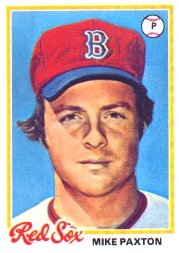Yes, I know what you’re thinking: A dreaded Red Sock. (Or is it Red Sox?) But there is method to my folly. After all, this card comes from Topps’ 1978 set, the favorite set of Bronx Banter chieftain Alex Belth. And it is an intriguing card because of its rather surreal appearance.
Over the years, Topps has airbrushed logos and uniform colors on countless cards, but during the seventies and eighties it was pretty rare for the company to use anything but actual photographs of players on the cards. In this case, we find an example of a card that seemingly had no photograph, only an apparent drawing, from the cap and the uniform to the player’s face, neck, and hair.
So who is Mike Paxton and why was a picture of him drawn onto his 1978 Topps rookie card (No. 216), rather than photographed? Well, I could answer the first question easily enough, but the second query remained a bit of a mystery. An ordinary player, Mike Paxton is probably best remembered for being included in the trade that sent Dennis Eckersley from the Indians to the Red Sox; in the deal, Eckersley and backup catcher Fred Kendall went to Boston in exchange for Paxton, veteran right-hander Rick Wise, third baseman Ted Cox, and catcher Bo Diaz. Prior to the trade, Paxton had risen through the Red Sox’ farm system in the mid-1970s, emerging as one of their better pitching prospects despite the lack of an overpowering fastball. As a rookie in 1977, Paxton made an immediate impact, winning 10 of 15 decisions as a sometime starter and reliever. Standing only 5’11" and sporting a lower body nearly as bowlegged as Bucky Dent, Paxton compensated for a lack of velocity with tenacity and a willingness to throw inside that earned him the nickname, "Bulldog."
More significantly, the soft-spoken Paxton was—and presumably still is—deeply religious, a devout Baptist and a member of the Fellowship for Christian Athletes. Initially, I thought that explained why his image was drawn and not photographed for the 1978 Topps card. Although I hadn’t been able to verify this through any written documentation, I had heard it speculated that Paxton and another pitcher, Seattle Mariners left-hander Rick Jones (who was featured on a 1977 Topps card), didn’t want to be photographed on their cards for religious reasons. Topps has always negotiated its contracts with players on an individual basis, so it seemed possible that Paxton and Jones specifically made the request for drawings, and not photographs, on their cards. While the religious interpretation seemed like as good a reason as any in explaining why a photograph wouldn’t be used at a time when photos of players were in large supply, it didn’t explain why Paxton’s two subsequent Topps cards (1979 and ’80) featured photographs and not drawings. Thus, the mystery continued.
As it turned out, religious reasons had nothing to do with the "drawings" on the Mike Paxton and Rick Jones cards. There existed a much simpler explanation, which I received from former Yankee public relations man Marty Appel, who has also done public relations work for Topps over the years. Appel says that it was simply a case of Topps not having color photographs for either player. As a result, Topps took a couple of black-and-white photos and "colorized" them, giving them the effect of looking like drawings. So technically this card does feature a photograph, though it has been given the Ted Turner treatment.
Yes, sometimes there are easy answers to seemingly complex mysteries; you simply have to know whom to ask.
Bruce Markusen writes "Cooperstown Confidential" for MLBlogs at MLB.com.



